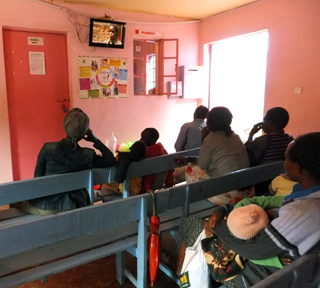Applying Strategic Thinking to Analyzing Organizations

Shining Hope for Communities developed an innovative, community-driven model to combat inter-generational cycles of poverty and gender inequality in Nairobi’s Kibera slum. The clinic sought ways to reduce wait time and increase efficiency. (Photo of clinic waiting room, courtesy of an MIT student.)
I became interested in organizations that have the trifecta of scale, sustainability and quality, and put together examples of these, as well as others that haven't quite gotten there, but are promising. Some of these organizations were well-known to students coming into the class, and some were not. At the same time, I tried to figure out the underlying organizing principles behind the class so that we didn’t just study a series of disconnected examples, but that we had some kind of structure and framework for understanding them.
One thing I discovered early on was that strategic thinking is often not applied with much rigor and depth in this domain. People may have looked into operations to understand why they are cost-effective, but they did not ask, what is the product or service offered, and to whom? At what price? Who are the competitors, and why are they better than those alternatives? That strategic thinking piece was often not that clear.
Just because someone has a solution to a problem doesn't mean it's the best solution. There might be other solutions in the market, but without rigorous thinking we may be missing what business discipline can bring to this domain. So I wanted to integrate a systematic lens from the strategy side that would let us keep asking these questions of every organization we looked at.
Another natural question was, how do we know these organizations are high quality? What was the data? So we dug into the evidence and data, and looked at how that organization was using their data. Did they have a learning or management process that evaluated how they were doing? Could they figure out the problems to solve, or how to do better? So we looked at the data, and we tried to see how they learned from their own data.
Then we asked, how are they organized, and what functions were they performing? Were they clever in using other assets and inputs so that they need not build and own a whole infrastructure, but slide in where there's a gap to leverage other components of the healthcare infrastructure? This led us to think about the care-delivery value chain, especially from the patient’s point of view.
This got students thinking right away because we find many people, especially at MIT, who are interested in creating new diagnostic technologies. But you can’t claim to be solving the world's health problems with a new ten-cent diagnostic if patients can’t get treated. All the necessary elements have to be provided: knowledge and information, money, transportation, treatment, disease management, and management of deterioration. Diagnosis by itself doesn't solve anybody's problem.
What matters to patients is whether they are healthy, having a good life, and whether the cost of care is bearable. There should be reasonable costs and good outcomes. So we wanted students to think about these issues from a systems thinking viewpoint.
Examining Organizational Operations
Just because someone has a solution to a problem doesn't mean it's the best solution.
Another way that systems thinking came into the class was by looking at how each organization runs. We wanted to understand whether the organization was exploiting economies of scale or scope, using learning-curve effects, building alliances to leverage others' unique capabilities and assets, and developing a depth of knowledge in a particular domain that is then applied systematically.
We tried to unpack the business model from the point of view of operations, including tapping into reinforcing feedback loops. Once you build some expertise, you can often build more. For example, if you become a really good surgeon, you attract trainee surgeons to come and work with you, and patients from all over will travel to come see you. You then have a bigger volume and variety of cases, and in turn you can build your skills further. Harnessing some of these reinforcing processes is a way to get really good quality care with low cost, and we recognized these huge returns to learning that can accrue if the system is managed well.
